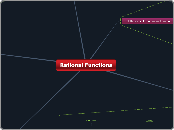Rational Functions
3.3 Rational Functions of the Form f(x) (ax+b)/(cx+d)
Properties of : Rational Functions of the form f(x) = (ax+b)/(cx+d)
Horizontal asymptotes
If n < m, y="0
If n = m, the horizontal asymptote is y = (coefficient of the x^n term) / (coefficient of the x^m term)
If n > m, there is no horizontal asymptote.
Vertical asymptotes
X = restriction of domain
y- intercept
: to find y-intercept, x =0
Eg: y=(2x^2+ 4)/(x-2)
y-intercept is -2
x- intercept
: to find x-intercept, y =0
Eg: y=x/(x-2)
x-intercept is 0
Domain
(2x^2+ 3)/(x+ 3)
Domain : {x є R / x ≠ -3}
3.4 Solve Rational Equations and Inequalities
Solve a Quadratic Over a Quadratic
Rational Inequality
Interval Table
Number line
Solve Simple Rational Inequalities
Solve Algebraically
Consider Key Features
Of the Graph
Determine sign of the expression
Use test points
Rewrite the right side to 0
Solve Rational Equations using Technology
CAS
Graphing Calculator
Solve Rational Equations Algebraically
3. Simply and solve it
1. Factor the expressions in the
numerator and denominator
2. Multiply both sides by the
factored denominator
3.5 Making Connections With Rational Functions and Equations
Special Cases
Factor and reduce where possible
Indicate restrictions on
the variables
Given an equation, (x-3)(x+2)/ x+2
f(x) = 3
Therefore, f(x) simplifies to a
linear relationship.
This is a special case of a line
that is discontinuous where x cannot be 2.
Full analysis
Verbal
Descriptions
Graphical
Algebraic
Solving Equations
Formulas
Numeric
Calculations
Ordered Pairs
Tables
3.2 Reciprocal of a Quadratic Function Example : y= 1/x^2
Function
The function is positive when xЄ(-∞,0) U (0,∞).
The function is increasing when xЄ(-∞,0) while its decreasing when xЄ(0,∞).
The slope is positive and increasing when xЄ(-∞,0) while the slope is negative and increasing when xЄ(0,∞).
End behaviour
As x approaches positive infinity, f(x) approaches 0 from above. As x approaches negative infinity, f(x) approaches 0 from the above also.
As x approaches 0 from right, f(x) approaches a positive infinity. As x approaches 0 from left, f(x) approaches a positive infinity too.
X-intercepts
none
Asymptotes
Vertical
vertical asymptote is also x=0.
y=0 is a horizontal asymptote as the function will never touch the x-axis.
Range
The range is yЄR y> 0 since f(x) can never be a zero.
Let the denominator be 0 to find out the domain and the vertical asymptote
x(x)=0
x=0
Therefore the domain is xЄR x 0
3.1 Reciprocal of a Linear Function
Properties of a Rational Function
Intervals
Negative
Positive
Range
Domain
Slope
Intercepts
Y-intercept
X-intercept
Asymptotes
Vertical
Horizontal
-Defined as the quotient of two polynomial functions
-Since division by zero is undefined, rational functions have special properties that polynomial functions do not have

